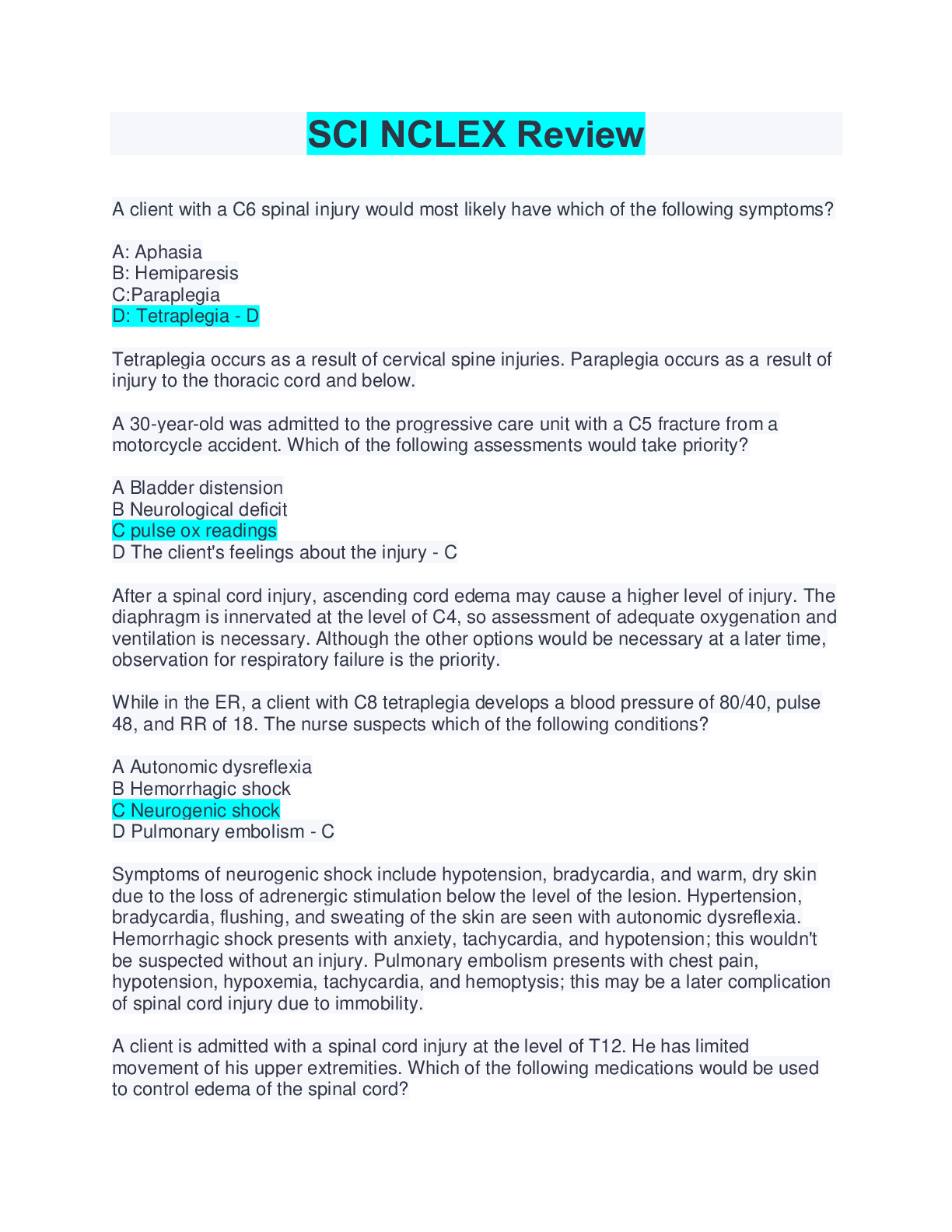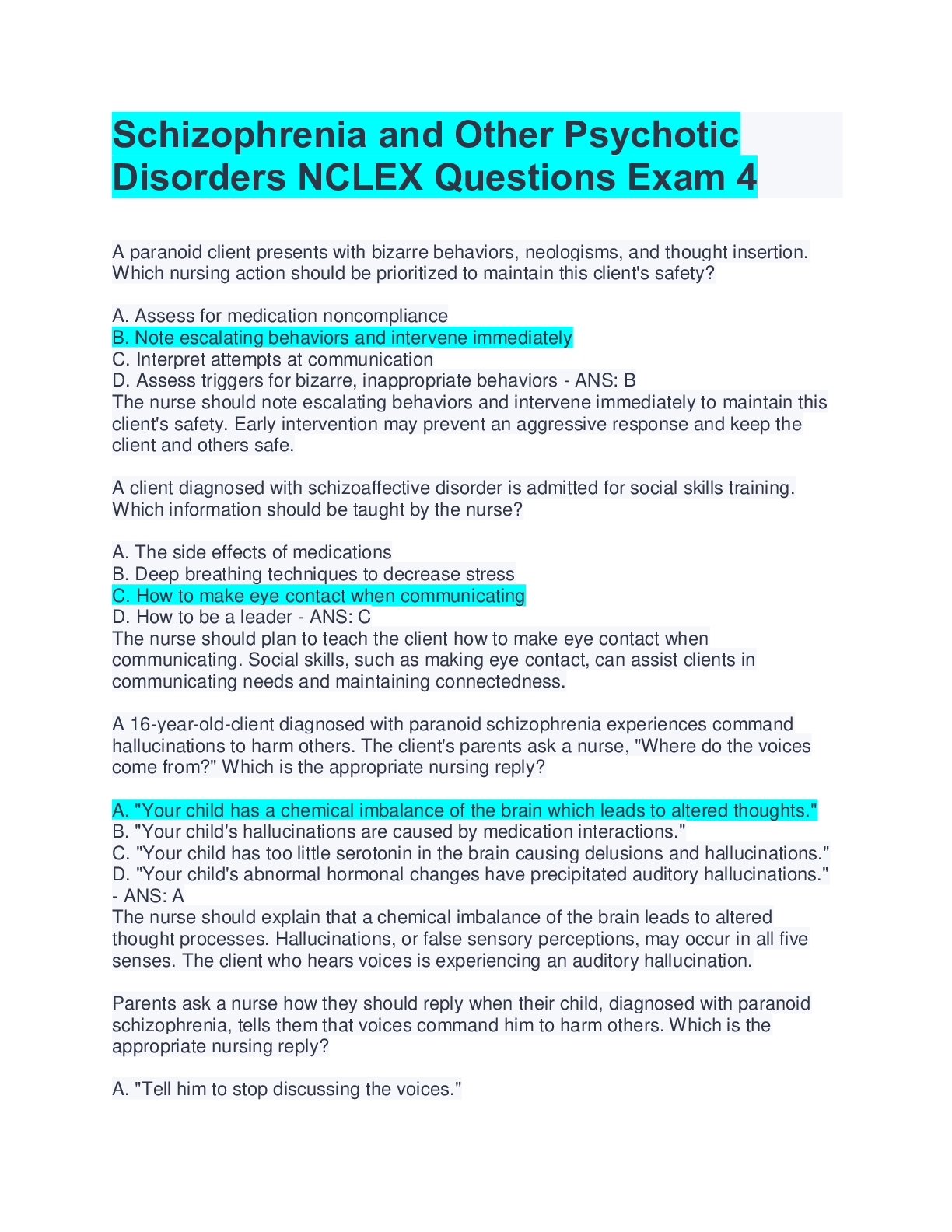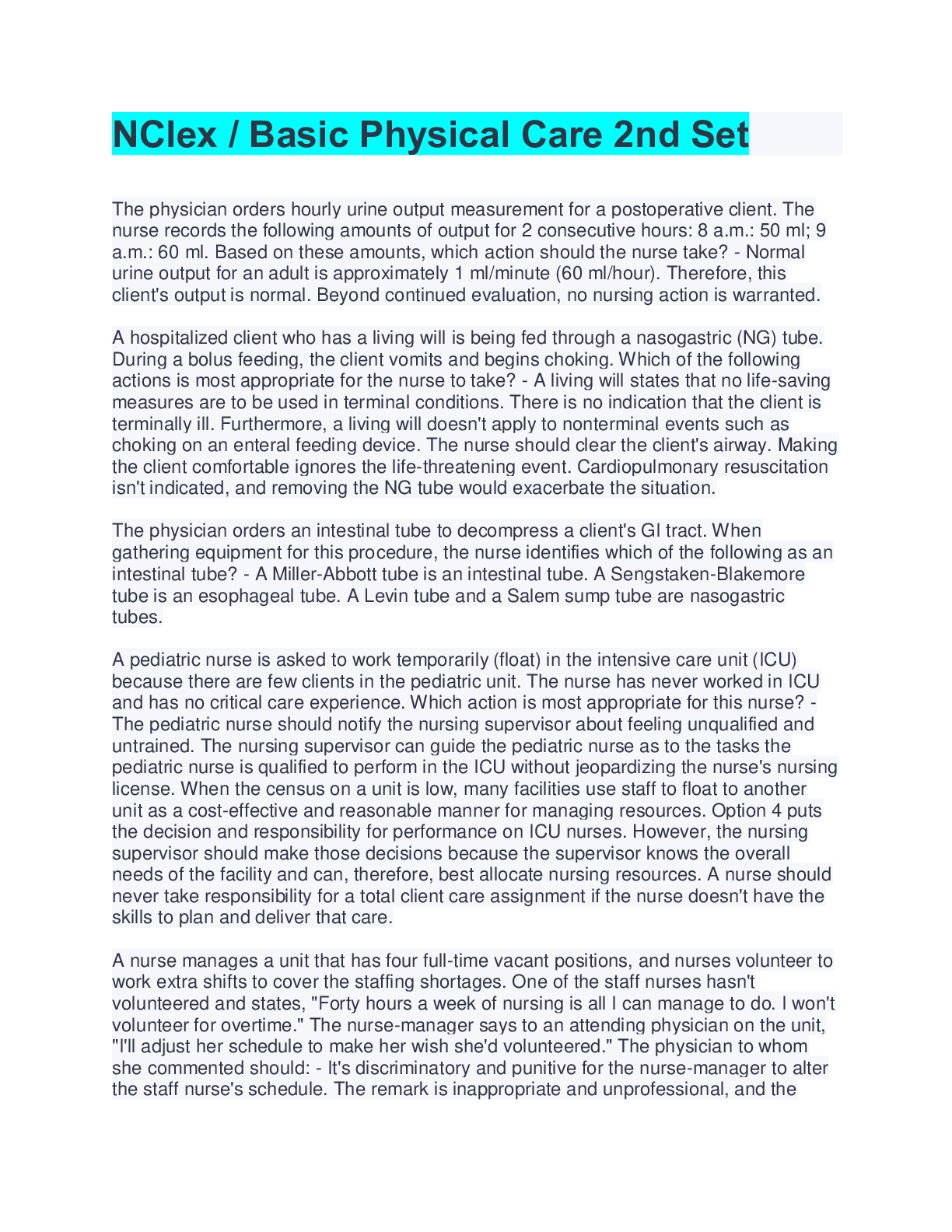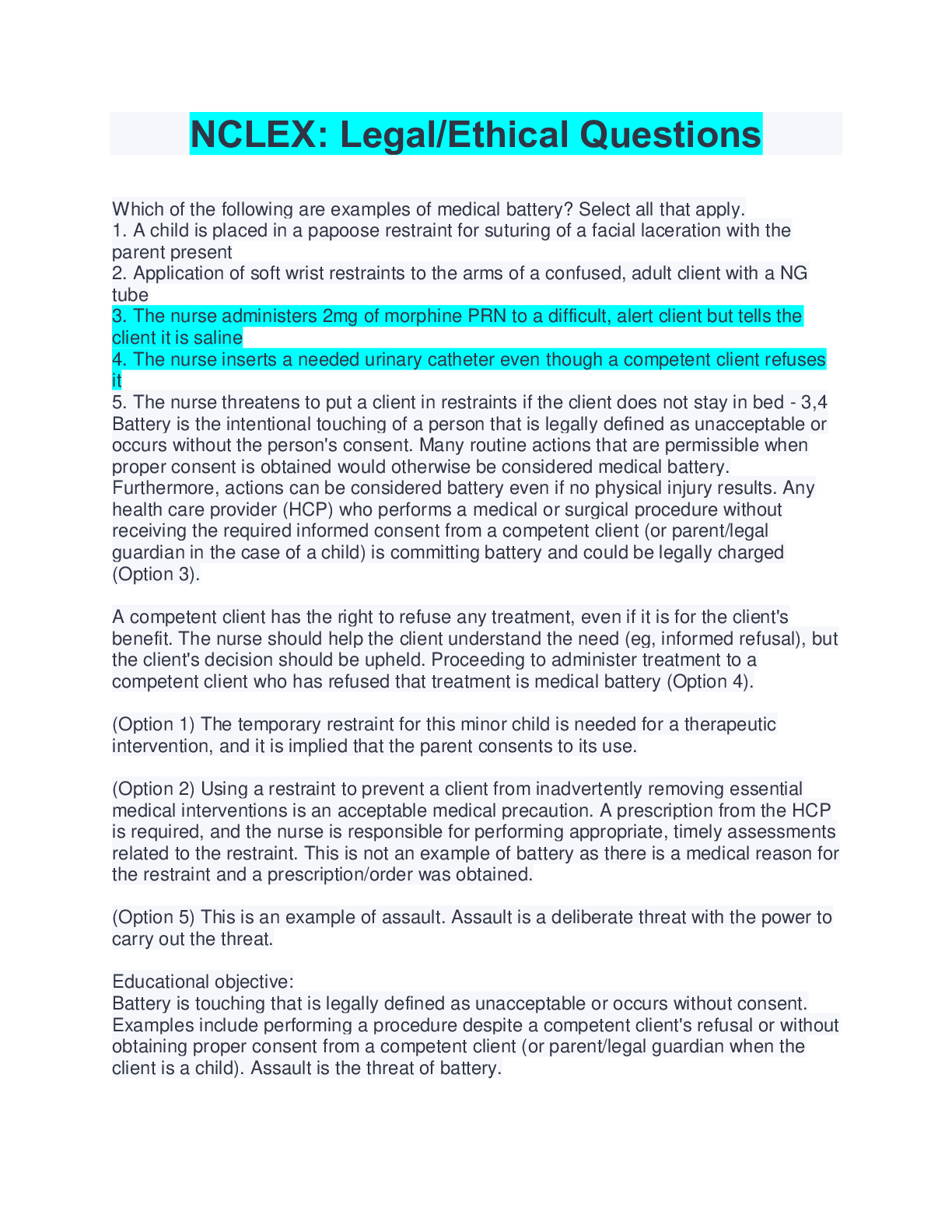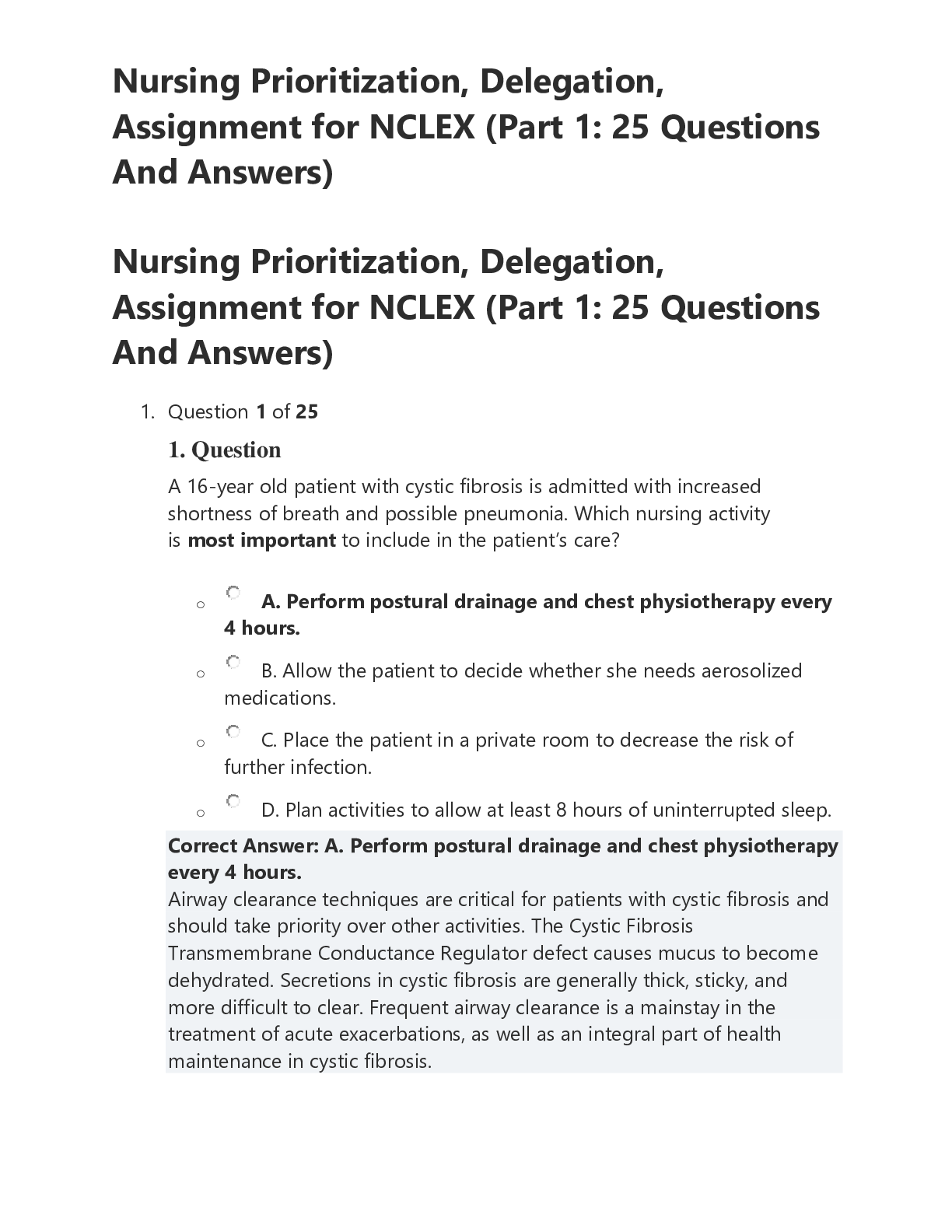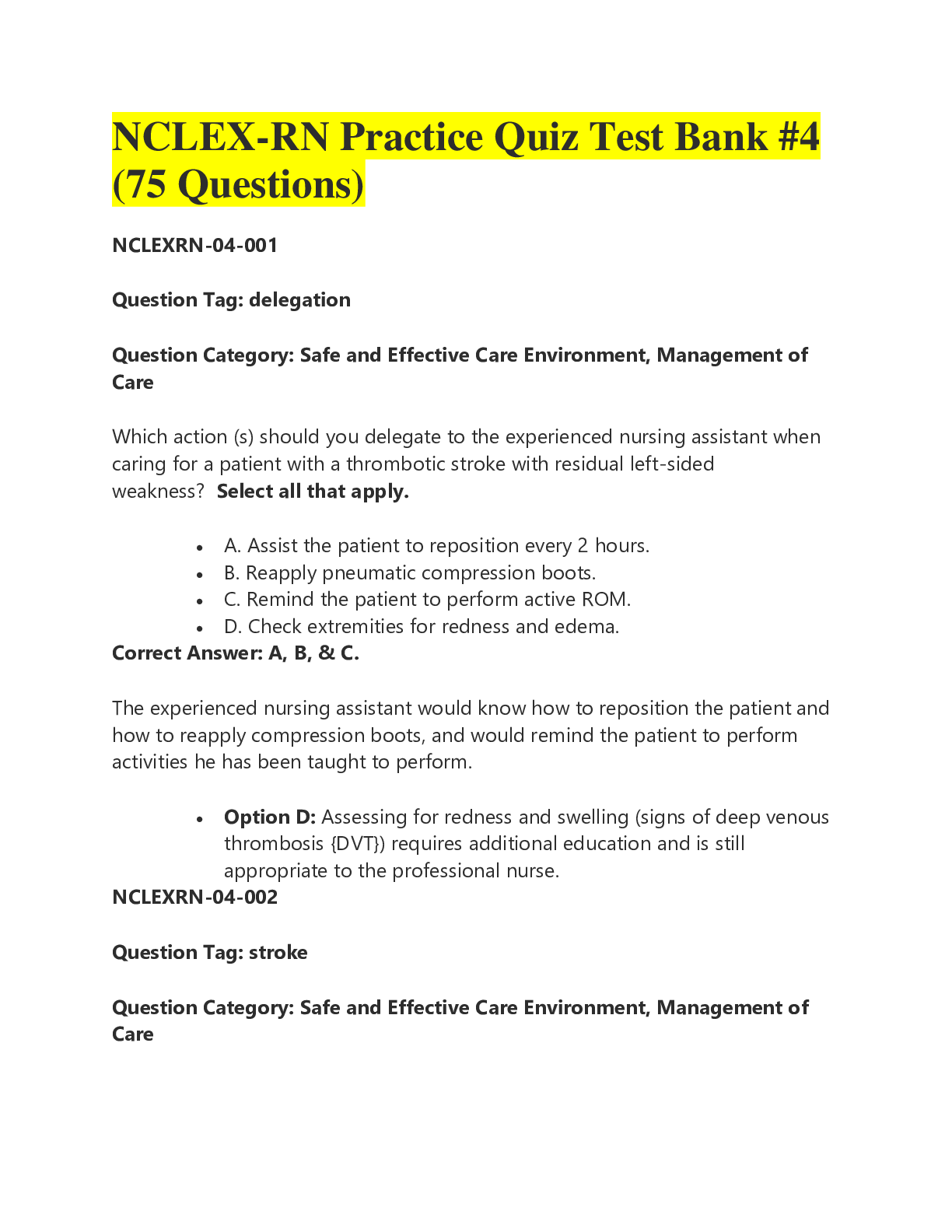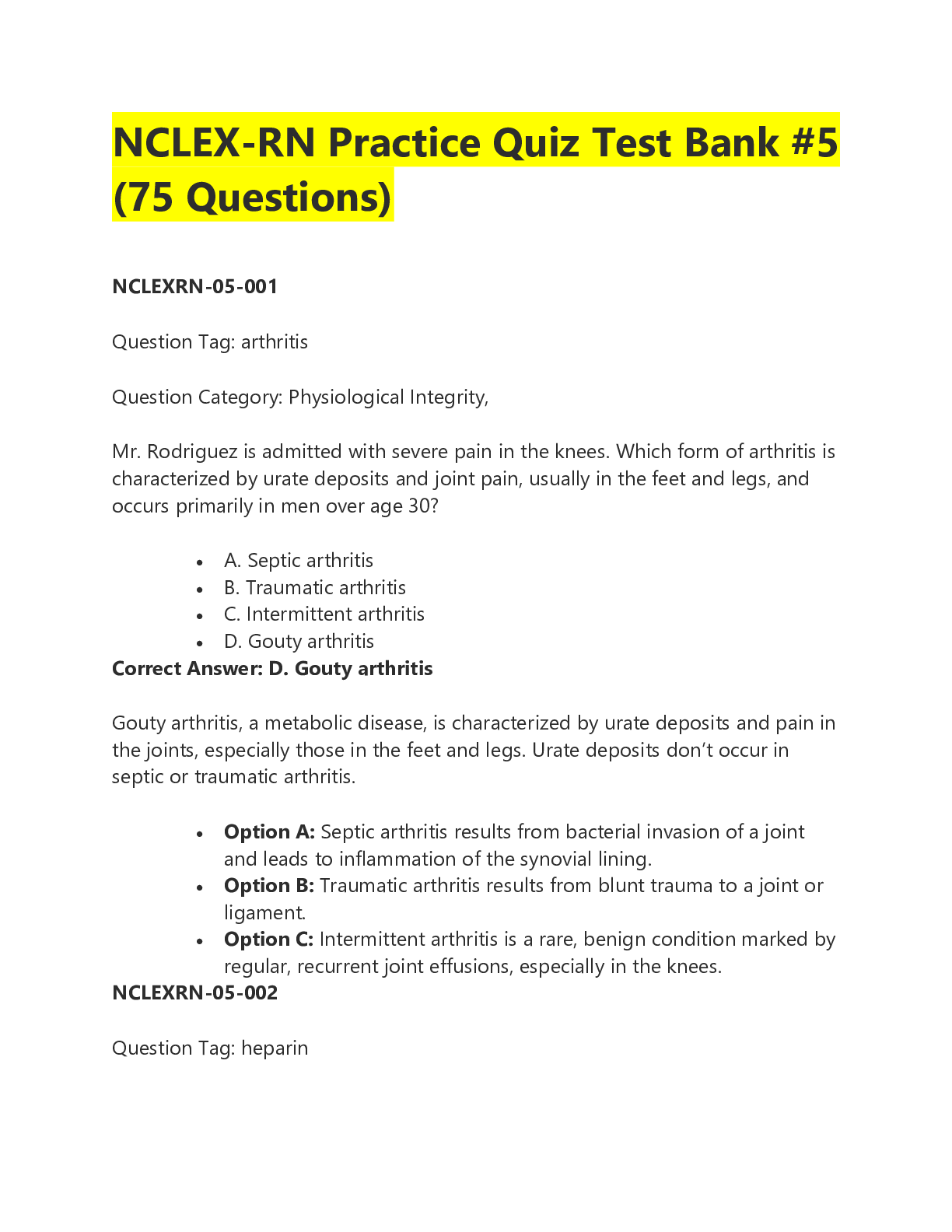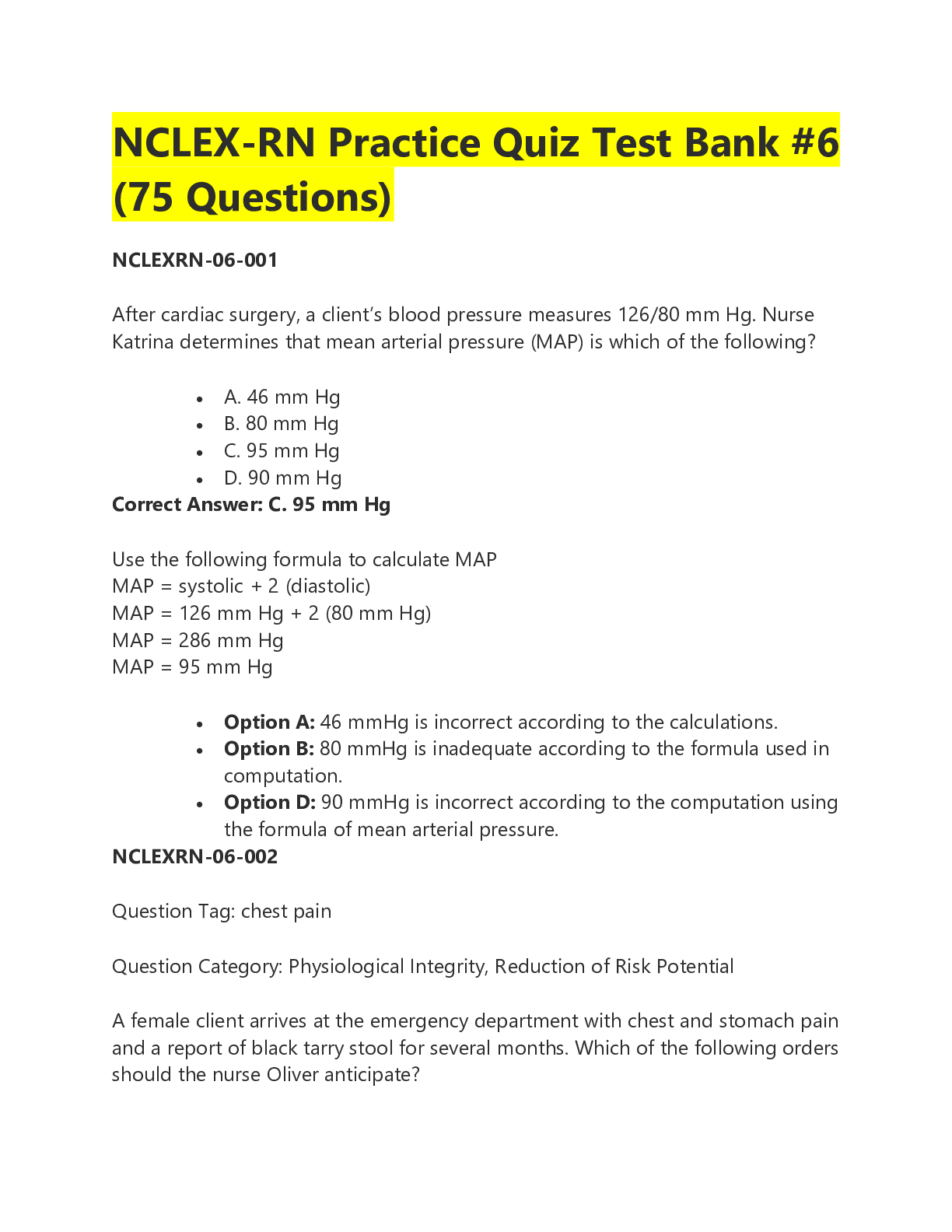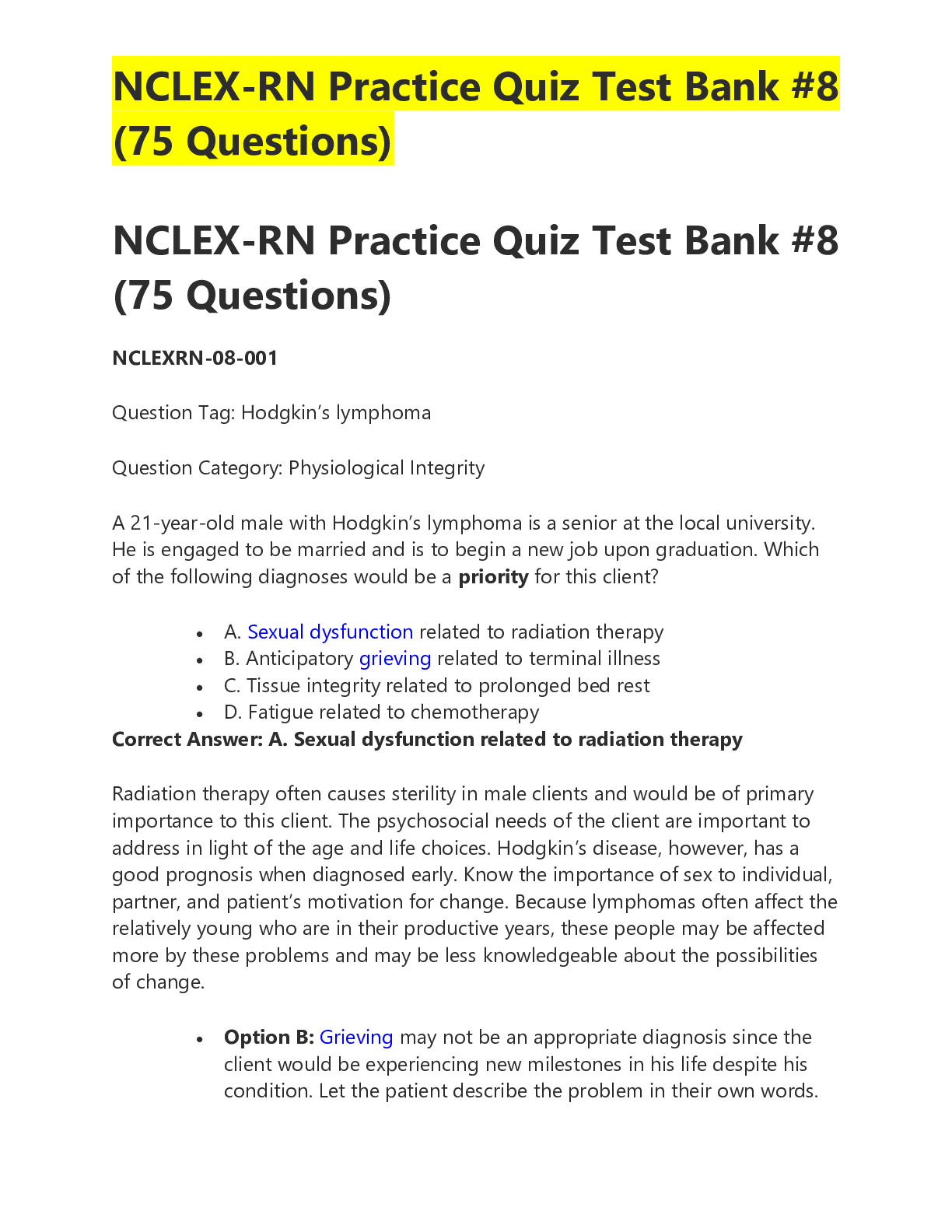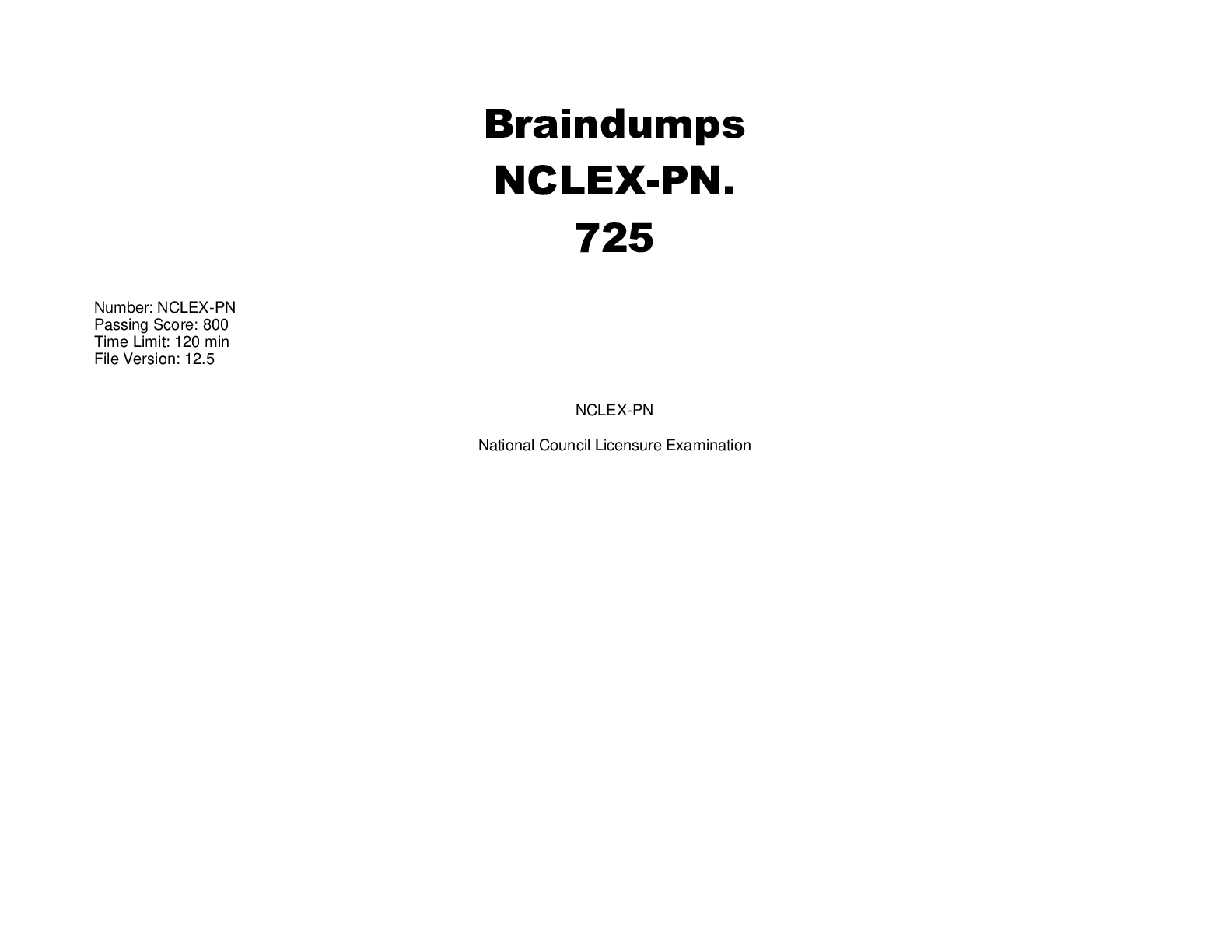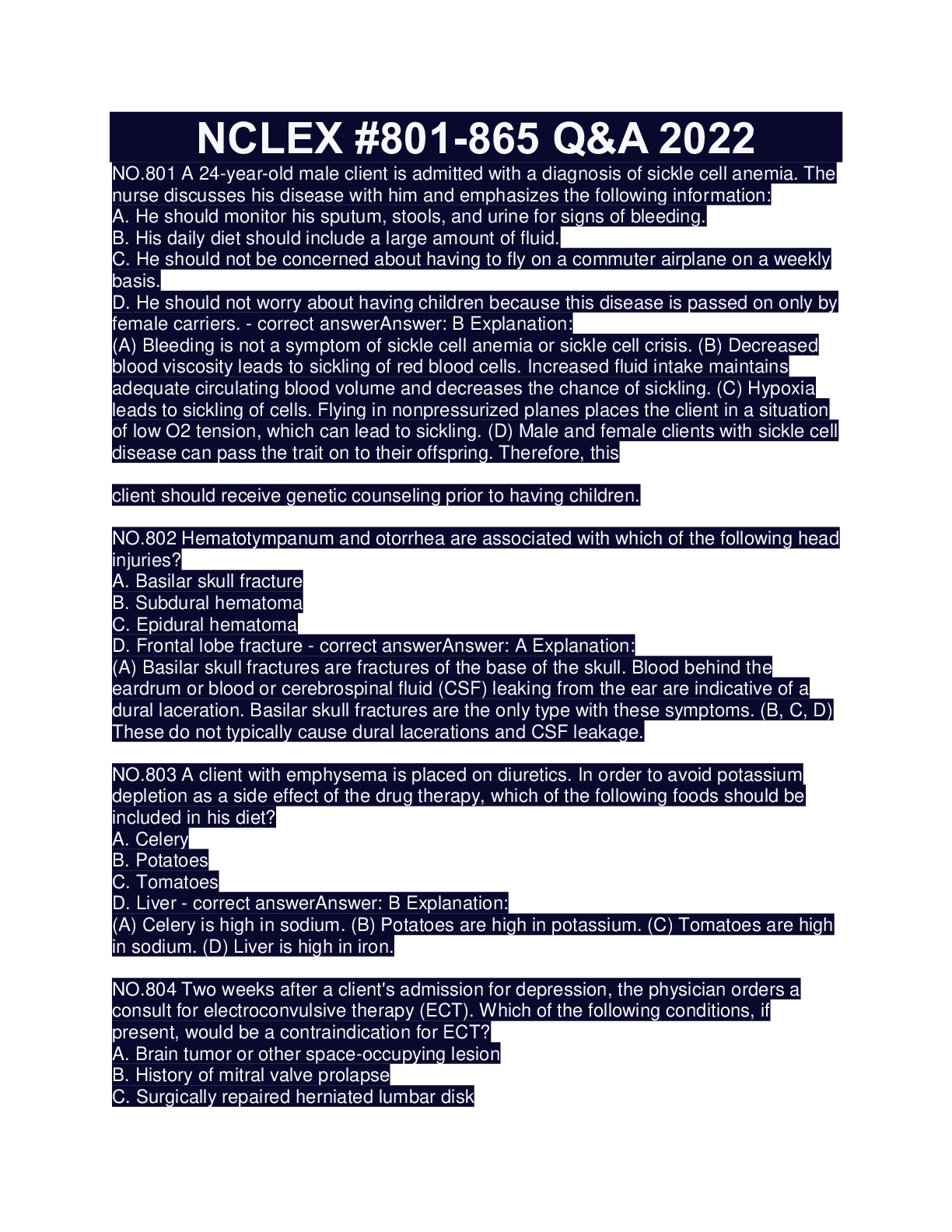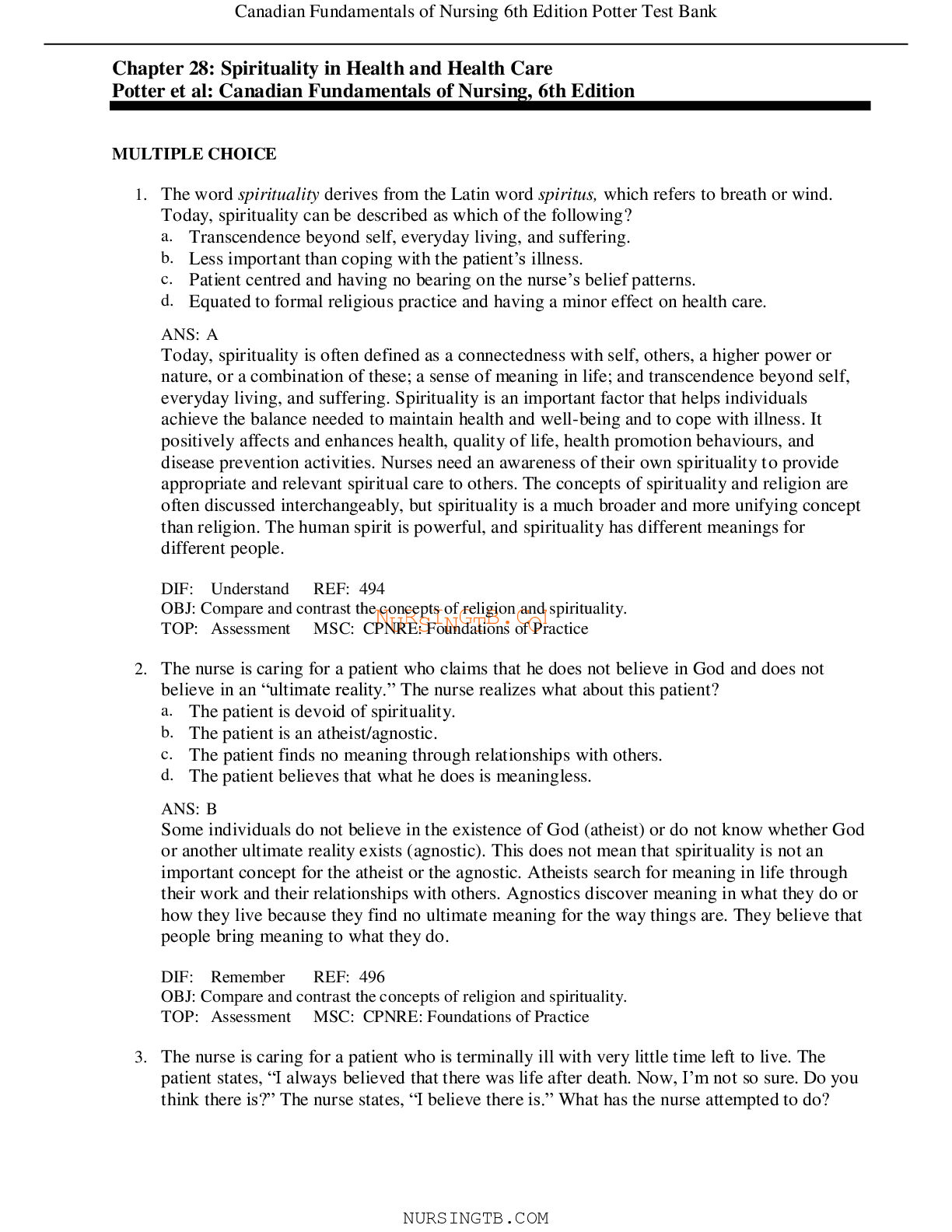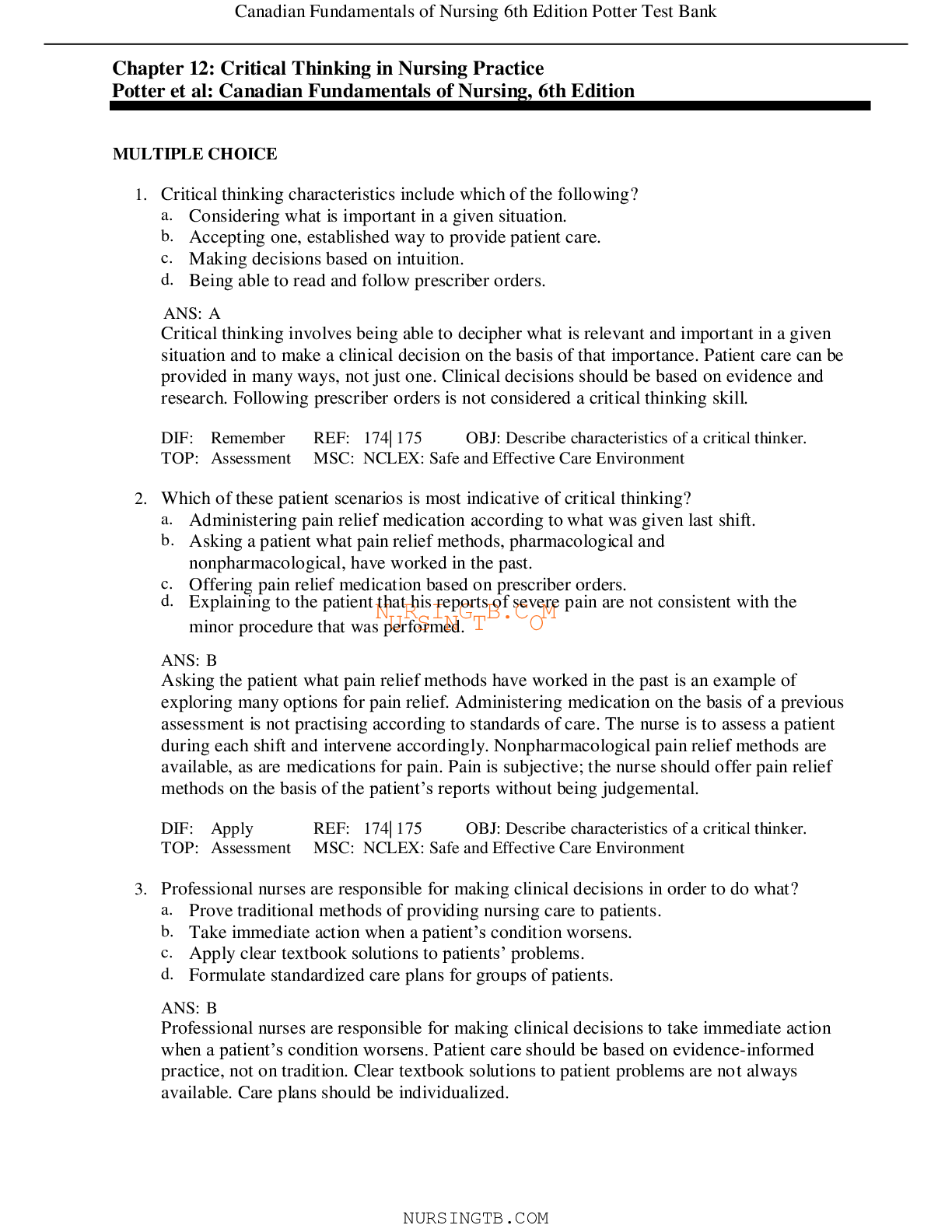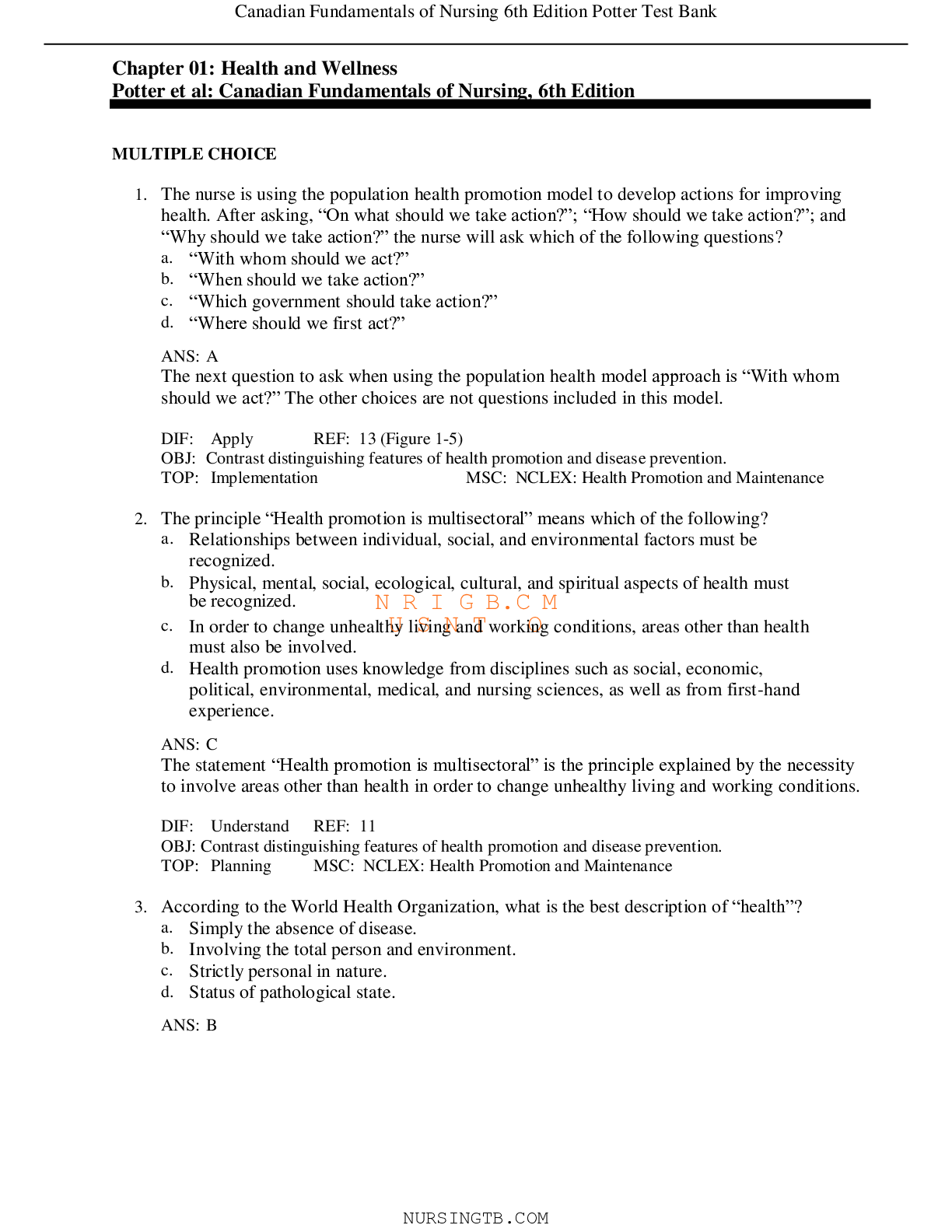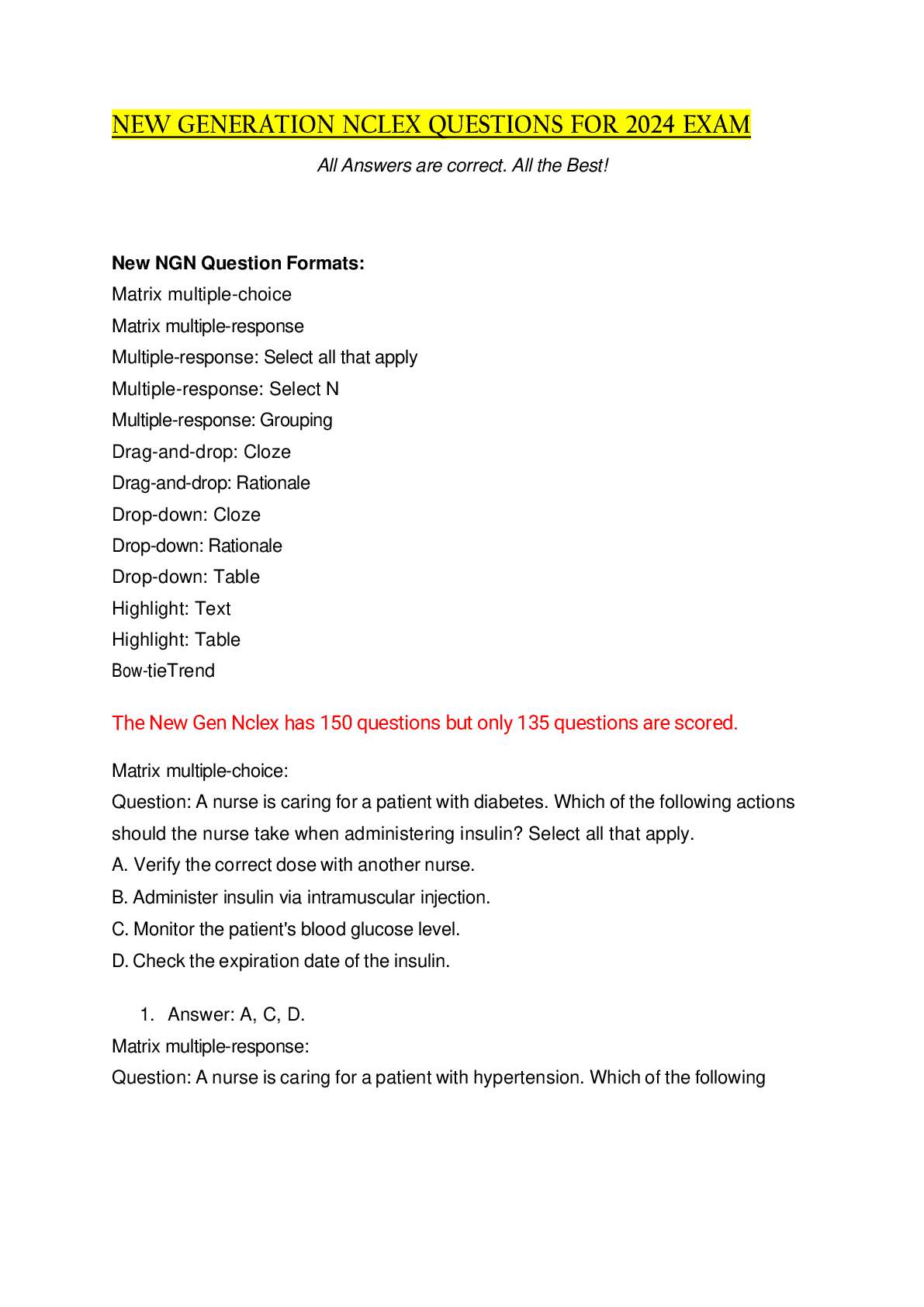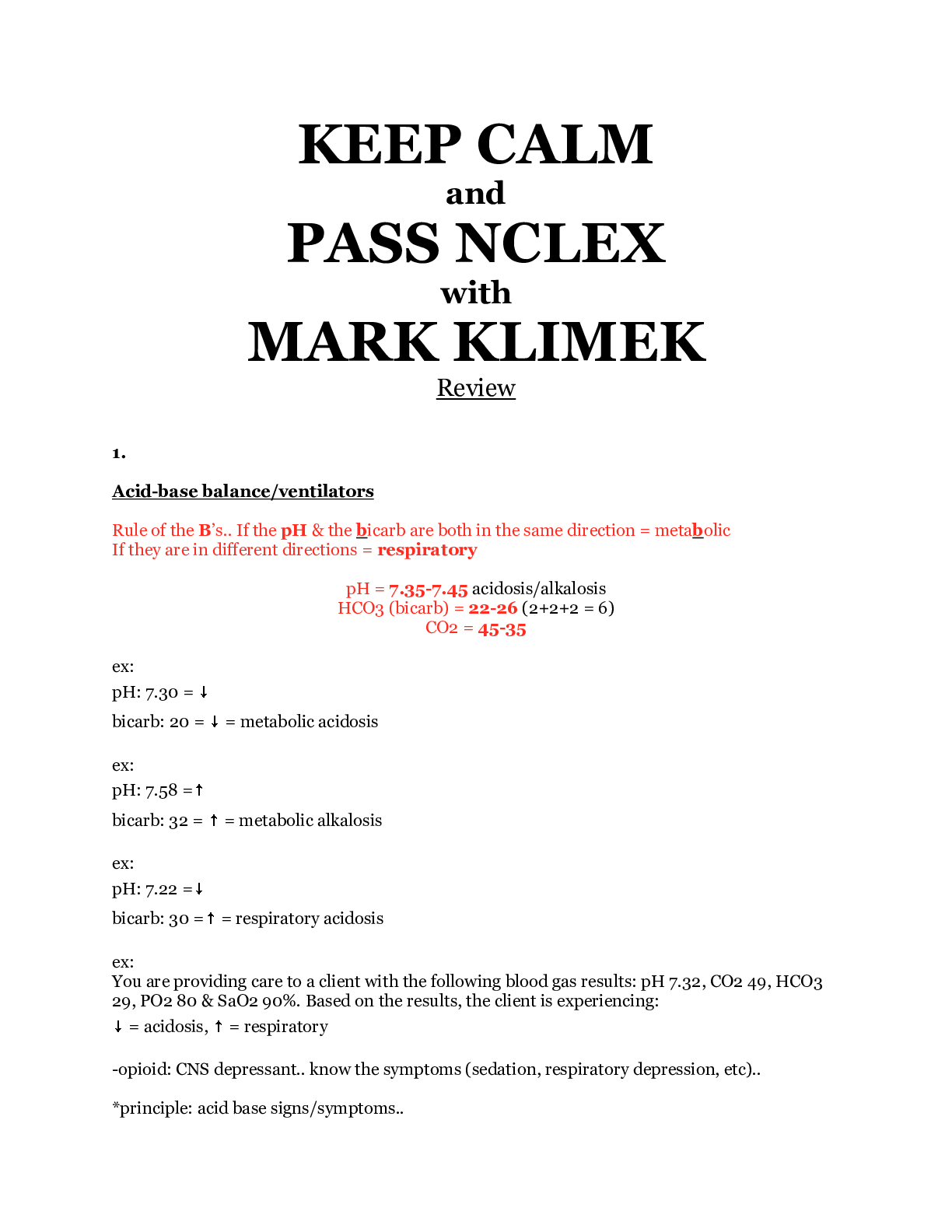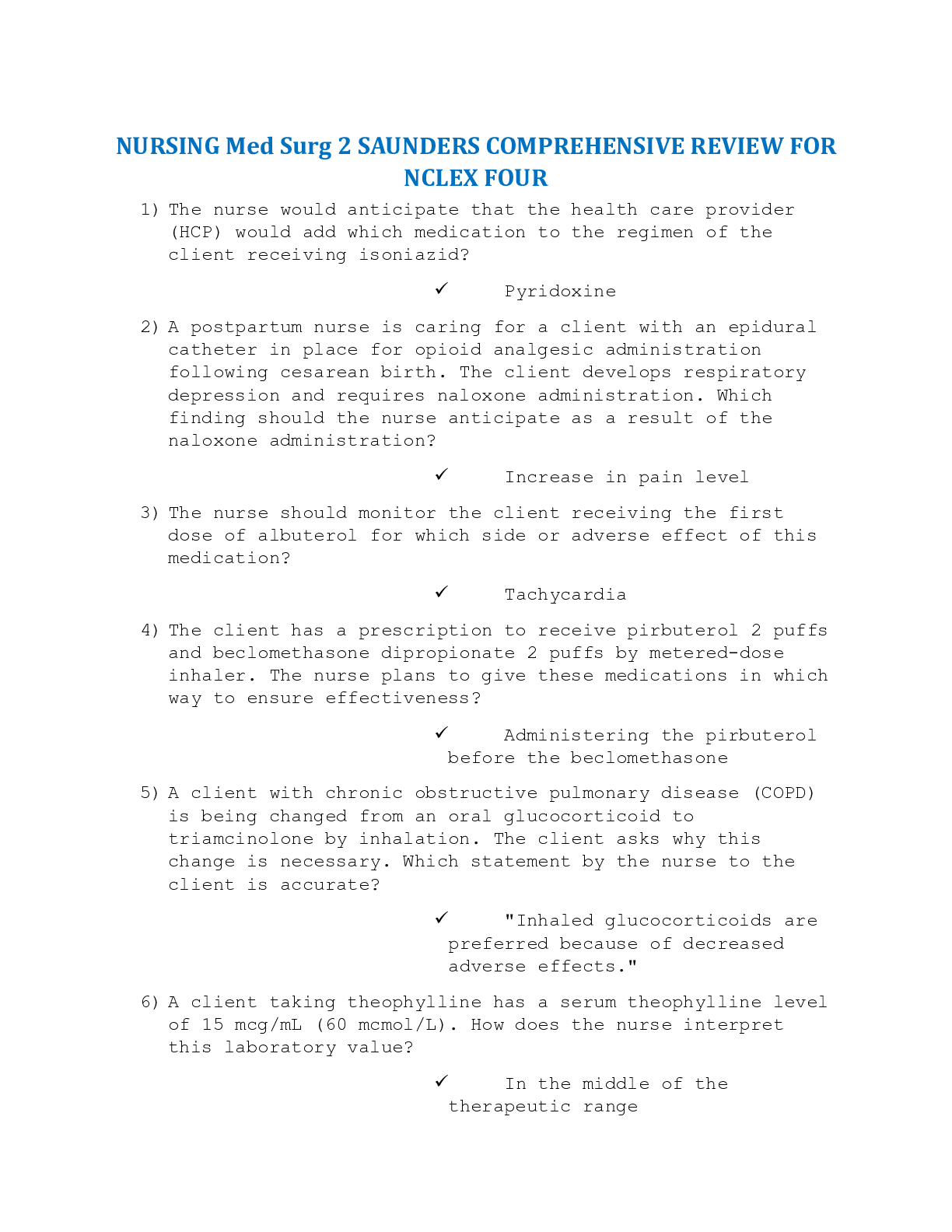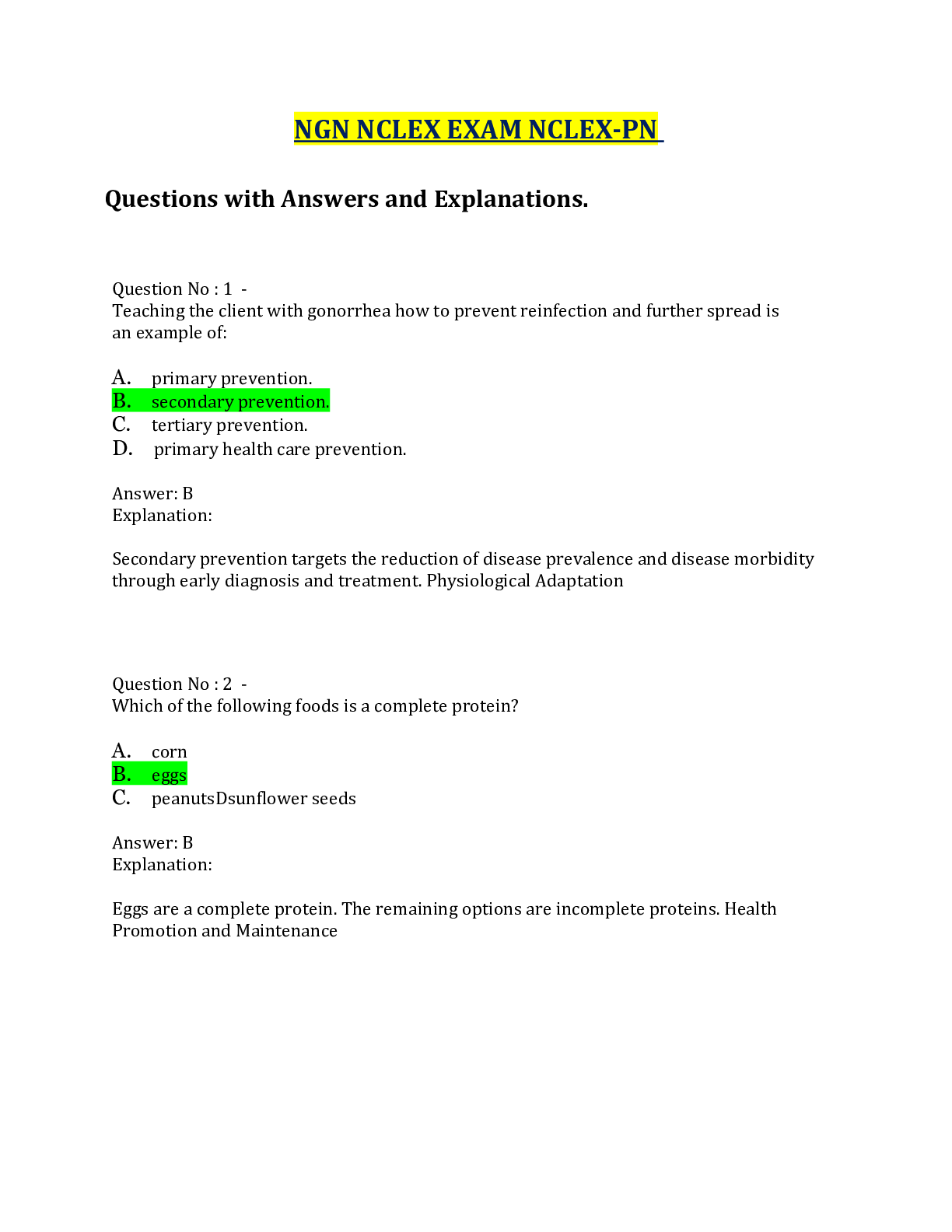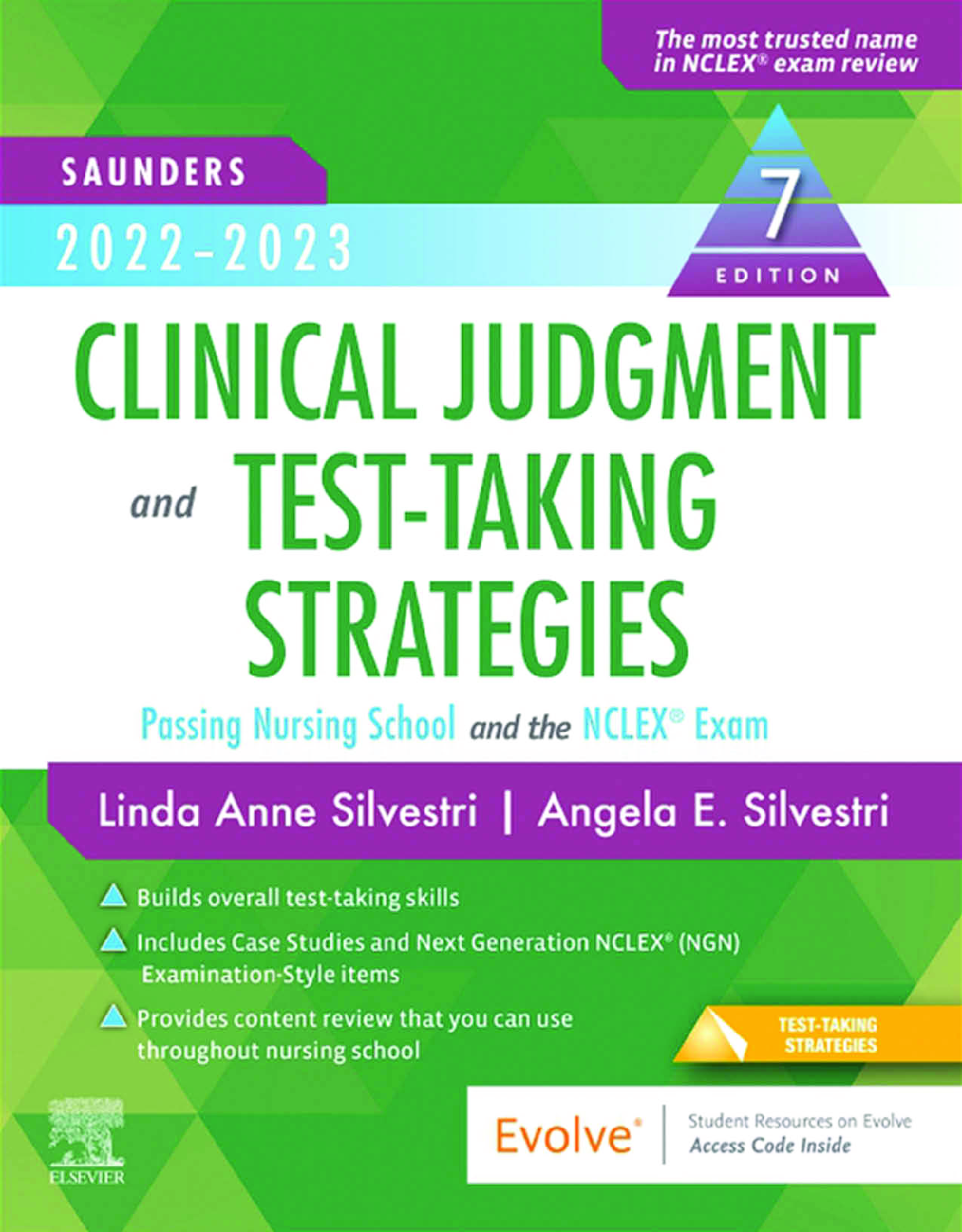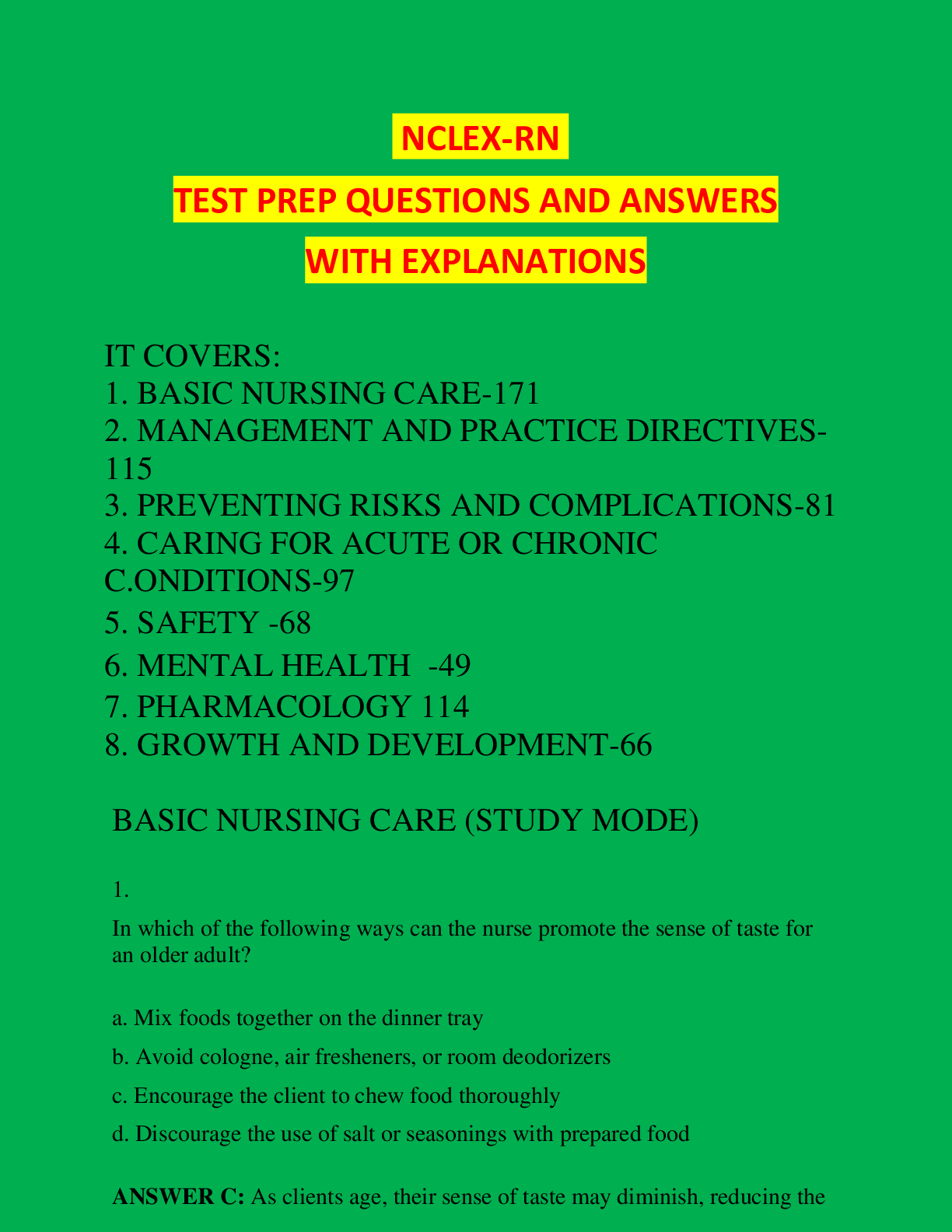*NURSING > NCLEX > Potter et al: Canadian Fundamentals of Nursing, 6th Edition/Chapter 38: Hygiene (All)
Potter et al: Canadian Fundamentals of Nursing, 6th Edition/Chapter 38: Hygiene
Document Content and Description Below
Chapter 38: Hygiene Potter et al: Canadian Fundamentals of Nursing, 6th Edition MULTIPLE CHOICE 1. A number of factors influence a patient’s personal preferences for hygiene. Because of th... is, what is important for the nurse to realize? 2. Social groups influence hygiene preferences and practices, including the type of hygienic products used and the nature and frequency of personal care. Which of the following developmental stages is most lUikelSy toNbe iTnfluencOed by family customs? 3. The patient received a diagnosis of diabetes 12 years ago. When admitted, the patient is unkempt and is in need of a bath and foot care. When questioned about his hygiene habits, the patient tells the nurse that baths are taken once a week where he comes from, although he takes a sponge bath every other day. To provide ultimate care for this patient, what must the nurse understand? 4. The nurse is caring for a patient who refuses “A.M. care.” When asked why, the patient tells the nurse that she always bathes in the evening. What should the nurse do? 5. Successful critical thinking requires synthesis of knowledge, experience, information gathered from patients, critical thinking qualities, and intellectual and professional standards. Once the assessment has been done, what is important for the nurse to understand? 6. When the nurse provides hygiene care for an older patient, why is it important for the nurse to closely assess the skin? 7. The nurse is bathing a patient and notices movement in the patient’s hair. The nurse should 8. The patient has been brought to the emergency department after a motor vehicle accident. The patient is unresponsive. His driver’s licence states that he needs glasses to operate a motor vehicle, but no glasses were brought in with the patient. What should the nurse do? 9. When assessing a patient’s skin, what does the nurse need to know? 10. The nurse is caring for a patient who is immobile. Why is the nurse aware that the patient is at risk for impaired skin integrity? 11. The nurse is caring for a patient who has diabetes mellitus and circulatory insufficiency, with peripheral neuropathy and urinary incontinence. What does the nurse know about patients with these conditions? 12. The nurse is caring for a patient who has undergone external fixation of a broken leg and has a cast in place. To prevent skin impairment, what should the nurse do? 13. Of the following interventions, which would be the most important for preventing skin impairment in a mobile patient with local nerve damage? 14. Of the following disorders, which is caused by a virus? 15. The nurse is caring for a patient who is complaining of severe foot pain from corns. The patient states that she has been using oval corn pads to self-treat the corns, but they seem to be getting worse. What does the nurse explain? 16. The patient receives a diagnosis of athlete’s foot (tinea pedis). The patient says that she is relieved because it is “only athlete’s foot” and it can be treated easily. What does the nurse explains about athlete’s foot? 17. When assessing a patient’s feet, the nurse notices that the toenails are thick and separated from the nail bed. What is this condition caused by? 18. The nurse is providing education about the importance of proper foot care to a patient who has diabetes mellitus. Why is this important? 19. The nurse is providing oral care to an unconscious patient and notes that the patient has extremely bad breath. What is the term for “bad breath”? 20. The nurse is caring for an unresponsive patient who has a nasogastric tube in place for continuous tube feedings. Why does the nurse assess the patient’s oral hygiene? 21. The patient is being treated for cancer with weekly radiation and chemotherapy treatments. The nurse is aware that the patient’s oral mucosa needs to be assessed because radiation therapy and chemotherapy can have what effects? 22. In providing oral care to an unconscious patient, what is an important action by the nurse? 23. The nurse is teaching the patient about flossing and oral hygiene. Which of the following is the nurse’s instruction? a. Flossing needs to be done at least three times a day. b. To prevent bleeding, the patient should use waxed floss. c. Flossing removes plaque and bacteria from the teeth. d. Applying toothpaste to the teeth before flossing is harmful. ANS: C Dental flossing removes plaque and bacteria between teeth. To prevent bleeding, the patient should use unwaxed floss. Flossing once a day is sufficient. If toothpaste is applied to the teeth before flossing, fluoride will come in direct contact with tooth surfaces, aiding in cavity prevention. DIF: Apply REF: 931 OBJ: Describe conditions that place the patient at risk for problems related to the hair, scalp, integument, feet, nails, eyes, ears, nose, mouth, and throat, and discuss their related interventions. TOP: Implementation MSC: NCLEX: Physiological Integrity 24. The nurse is caring for a patient who has head lice (pediculosis capitis). What should the nurse know about treating this condition? a. Products containing lindane are most effective. b. Head lice may spread to furniture and other people. c. Treatment must be repeated in 7 to 10 days. d. Manual removal is not a realistic option as treatment. ANS: B Head lice are difficult to remove and spread to furniture and other people if not treated. Products containing lindane should not be used because the ingredient is toxic and is known to cause adverse reactions. Treatments need to be repeated 12 to 24 hours after the initial treatment. Manual removal is the best option when treatment has failed. DIF: Understand REF: 910 (Table 38-4) OBJ: Describe conditions that place the patient at risk for problems related to the hair, scalp, integument, feet, nails, eyes, ears, nose, mouth, and throat, and discuss their related interventions. TOP: Assessment MSC: NCLEX: Physiological Integrity 25. Scaling of the scalp accompanied by itching is known as which of the following? a. Dandruff. b. Pediculosis. c. Alopecia. d. Ticks. ANS: A Dandruff is scaling of the scalp that is accompanied by itching. Pediculosis (lice) consists of tiny, greyish-white parasitic insects that infest mammals. Alopecia is hair loss or balding. Ticks are small, grey-brown NpaUraRsiSteIs NthGatTbBur.roCwOinMto the skin and suck blood. DIF: Remember REF: 910 (Table 38-4) OBJ: Describe conditions that place the patient at risk for problems related to the hair, scalp, integument, feet, nails, eyes, ears, nose, mouth, and throat, and discuss their related interventions. TOP: Assessment MSC: NCLEX: Physiological Integrity 26. In finding pediculosis capitis (head lice) in a patient, what would the nurse expect to observe? a. Greyish-white parasites with red legs. b. Pustules or bites behind ears and at the hairline. c. Balding patches in periphery of the hairline. d. Brittle and broken hair. ANS: B Head lice are on the scalp, attached to hair stands. Bites or pustules may be observed behind the ears and at the hairline. Greyish-white parasites with red legs are pediculosis pubis (crab lice), not head lice, and are found in pubic hair. Alopecia (hair loss) is found in people of all ethnicities and is characterized by brittle and broken hair and balding patchiness in the periphery of the hairline. DIF: Remember REF: 910 (Table 38-4) OBJ: Describe conditions that place the patient at risk for problems related to the hair, scalp, integument, feet, nails, eyes, ears, nose, mouth, and throat, and discuss their related interventions. TOP: Assessment MSC: NCLEX: Physiological Integrity 27. The nurse is caring for a patient who has multiple ticks on her legs and body. To rid the patient of ticks, what should the nurse do? a. Burn the ticks in an ashtray once removed. b. Use blunt tweezers and pull upward with steady pressure. c. Allow the ticks to drop off by themselves. d. Use products containing lindane to kill the ticks. ANS: B Using blunt tweezers, the nurse grasps the tick as close to its head as possible and pulls upward with even, steady pressure. The nurse holds the tick until it pulls out, usually for about 3 to 4 minutes. The tick should be saved in a plastic bag and put in the freezer if necessary to identify the type of tick. Because ticks transmit several diseases to people, they must be removed. Allowing them to drop off by themselves is not an option. Lindane is an ingredient that was used in treatment for pediculosis capitis (head lice); it should no longer be used because the ingredient is toxic and is known to cause adverse reactions. DIF: Apply REF: 910 (Table 38-4) OBJ: Describe conditions that place the patient at risk for problems related to the hair, scalp, integument, feet, nails, eyes, ears, nose, mouth, and throat, and discuss their related interventions. TOP: Implementation MSC: NCLEX: Physiological Integrity 28. The patient received a diagnosis of pediculosis capitis (head lice), was treated upon admission and re-treated 24 hours later, and yet the patient still has the infestation. What should be the nurse’s next action? a. Re-treat the patient with a medicated shampoo for eliminating lice. b. Use a product containing lindane to get rid of the lice. c. Manually remove the lice using a fine-toothed comb. d. Have the patient bathe or shUowSer tNhoroTughly. O ANS: C Manual removal is the best option when treatment has failed. Re-treating with a medicated shampoo may lead to adverse reactions and should not be done without consulting the care provider. Products containing lindane should not be used because the ingredient is toxic and is known to cause adverse reactions. Although bathing or showering is a good idea, this is usually considered a treatment for pediculosis corporis (body lice), not pediculosis capitis (head lice). DIF: Apply REF: 910 (Table 38-4) OBJ: Describe conditions that place the patient at risk for problems related to the hair, scalp, integument, feet, nails, eyes, ears, nose, mouth, and throat, and discuss their related interventions. TOP: Implementation MSC: NCLEX: Physiological Integrity 29. The nurse is caring for an older patient with Alzheimer’s disease who is ambulatory but requires total assistance with his activities of daily living (ADLs). The nurse notices that his skin is dry and wrinkled. What should the nurse do? a. Make sure that the patient is receiving daily baths. b. Reduce the number of baths per week if possible. c. Be aware that sweat glands become more active with aging. d. Be sure that the patient is using soap with his bath. ANS: B Decreasing the number of baths per week may help prevent further drying of the skin. As people age, the skin loses its resiliency and moisture, and sebaceous and sweat glands become less active. Daily bathing as well as bathing with water that is too hot or soap that is harsh causes the skin to become excessively dry. DIF: Apply REF: 918 (Box 38-9) OBJ: Describe how hygiene care for the older patient may differ from that for the younger patient. TOP: Implementation MSC: NCLEX: Health Promotion and Maintenance 30. A self-sufficient bedridden patient unable to reach all body parts needs which type of bath? a. Complete bed bath. b. Bag bath. c. Sponge bath. d. Partial bed bath. ANS: D A partial bath consists of washing body parts that the patient cannot reach, including the back, and providing a back rub. Dependent patients in need of partial hygiene care or self-sufficient bedridden patients who are unable to reach all body parts receive a partial bed bath. Complete bed baths are administered to totally dependent patients in bed. The bag bath contains several soft, nonwoven cotton cloths that are premoistened in a solution of no-rinse surfactant cleanser and emollient. It can be used for any patient. The sponge bath involves bathing from a bath basin or a sink with the patient sitting in a chair. DIF: Remember REF: 918 OBJ: Discuss the different approaches used in maintaining a patient’s comfort and safety during hygiene care. TOP: Assessment MSC: NCLEX: Health Promotion and Maintenance NURSINGTB.COM 31. The nurse is preparing to provide a complete bed bath to an unconscious patient. The nurse decides to use a bag bath. She does this for which of the following reasons? a. Washbasins can harbour Gram-negative organisms. b. Bag baths entail the use of soaps that enhance cleansing. c. Bag baths do not contain emollients. d. Bag baths increase skin flaking and scaling. ANS: A When washbasins are not cleaned and dried completely after use, they are more likely to be contaminated by Gram-negative organisms. Successive uses of the washbasin cause the patient’s skin to harbour more gram-negative organisms. Bag baths do not contain soap. Instead, they contain a no-rinse surfactant, a humectant to trap moisture, and an emollient that significantly reduces overall skin dryness, especially skin flaking and scaling. DIF: Understand REF: 926 OBJ: Discuss the different approaches used in maintaining a patient’s comfort and safety during hygiene care. TOP: Assessment MSC: NCLEX: Health Promotion and Maintenance 32. The female nurse is caring for a male patient who is uncircumcised and not ambulatory, although he has full function of arms and hands. The nurse is providing the patient with a partial bed bath. What statement is true for perineal care for this patient? a. It is not necessary because he is not circumcised. b. It should be postponed because it may cause him embarrassment. c. It should be done by the patient. d. It should be done by the nurse. ANS: C Patients most in need of perineal care are those at greatest risk for acquiring an infection, such as uncircumcised male patients. If a patient is able to perform perineal self-care, the nurse should encourage this independence. Embarrassment should not cause the nurse to overlook the patient’s hygiene needs. The nurse should provide this care only if the patient is unable to do so. DIF: Apply REF: 926 OBJ: Discuss the different approaches used in maintaining a patient’s comfort and safety during hygiene care. TOP: Implementation MSC: NCLEX: Health Promotion and Maintenance 33. After the patient’s bath, what should the nurse do? a. Not offer a back rub because it is not therapeutic. b. Routinely give back rubs of 2 minutes’ duration or less. c. Assume that all patients need back rubs after their bath. d. Not offer a back rub for 48 hours after the patient has undergone coronary artery bypass surgery. ANS: D Consult the medical record for any contraindications to a massage (e.g., fractured ribs, burns, heart surgery). A back rub of 3 minutes’ duration actually enhances patient comfort and relaxation and thus is very therapeutic. It is important to ask whether a patient would like a back rub because some individuals dislike physical contact. DIF: Apply N R I G B.C M REF: 927 (Box 38-10) OBJ: Discuss the different approaches used in maintaining a patient’s comfort and safety during hygiene care. TOP: Implementation MSC: NCLEX: Physiological Integrity 34. The nurse is providing a complete bed bath to a patient with a commercial bath cleansing pack (bag bath). What should the nurse do? a. Use one towel for the entire bath. b. Dry the skin with a towel. c. Allow the skin to air dry. d. Not use a bath blanket or towel. ANS: C The nurse should allow the skin to air dry for 30 seconds. Drying the skin with a towel removes the emollient that is left behind after the water/cleanser solution evaporates. It is permissible to lightly cover the patient with a bath blanket or towel to prevent chilling. The cleansing pack contains 8 to 10 premoistened towels for cleansing. A single towel is used for each general body part cleansed. DIF: Apply REF: 926 OBJ: Successfully perform hygiene care of the integument; perineum; feet, hands, and nails; mouth; and eyes, ears, and nose. TOP: Implementation MSC: NCLEX: Health Promotion and Maintenance 35. In providing perineal care to a female patient, how should the nurse wash? a. Upward from rectum to pubic area. b. From back to front. c. From pubic area to rectum. d. In a circular motion. ANS: C Cleansing from pubic area to rectum (front to back) reduces the transfer of microorganisms to the urinary meatus and decreases the risk of urinary tract infection. Cleansing from rectum to pubic area or back to front increases the risk of urinary tract infection. Circular motions are used in male perineal care. DIF: Apply REF: 923 OBJ: Successfully perform hygiene care of the integument; perineum; feet, hands, and nails; mouth; and eyes, ears, and nose. TOP: Implementation MSC: NCLEX: Health Promotion and Maintenance 36. The nurse is providing perineal care to an uncircumcised male patient. When providing such care, how should the nurse treat the foreskin? a. Leave the foreskin alone because there is little chance of infection. b. Retract the foreskin for cleansing and allow it to return on its own. c. Retract the foreskin and keep retracted. d. Retract the foreskin and return it to its natural position when done. ANS: D Return the foreskin to its natural position. Keeping the foreskin retracted leads to tightening of the foreskin around the shaft of the penis, causing local edema and discomfort. The foreskin may not return to its natural pNosiRtionIon Gits oBw.nC. PaMtients at greatest risk for infection are uncircumcised boys and men. DIF: Apply REF: 923 OBJ: Successfully perform hygiene care of the integument; perineum; feet, hands, and nails; mouth; and eyes, ears, and nose. TOP: Implementation MSC: NCLEX: Health Promotion and Maintenance 37. Patients with diabetes mellitus need special foot care to prevent the development of ulcers. Knowing this, what is the nurse’s action? a. Trimming the patient’s toenails daily. b. Having the patient soak his or her feet twice a day. c. Requesting a consult with a nail care specialist. d. Assessing the brachial artery. ANS: C Patients with peripheral vascular disease or diabetes mellitus often require nail care from a specialist to reduce the risk of infection. Some agencies allow cutting of nails with a provider’s order; however, most do not. Patients with diabetes do not soak hands and feet; soaking increases the risk of infection because of maceration of the skin. When assessing the patient’s feet, the nurse palpates the dorsalis pedis of the foot, not the brachial artery. DIF: Apply REF: 926-927 OBJ: Successfully perform hygiene care of the integument; perineum; feet, hands, and nails; mouth; and eyes, ears, and nose. TOP: Implementation MSC: NCLEX: Health Promotion and Maintenance 38. The uncooperative patient is resisting attempts by the nurse to provide oral hygiene care. To provide the needed care, what may the nurse do? a. Use a padded tongue blade. b. Hold the patient’s mouth open with his or her own fingers. c. Position the patient on his or her back. d. Use undiluted hydrogen peroxide as a cleaner. ANS: A If the patient is unconscious or uncooperative or is having difficulty keeping the mouth open, a padded tongue blade can help. It is inserted over the tongue to keep the teeth apart when the patient is relaxed. The nurse must not use force. The nurse must never place fingers into the mouth of an unconscious or debilitated patient; the normal response of the patient is to bite down. The patient should be positioned on the side, or the head turned, to allow for drainage. Placing the patient on the back could lead to aspiration. Hydrogen peroxide and sodium bicarbonate effectively remove debris but, if not diluted carefully, may cause superficial burns. DIF: Apply REF: 934 OBJ: Successfully perform hygiene care of the integument; perineum; feet, hands, and nails; mouth; and eyes, ears, and nose. TOP: Implementation MSC: NCLEX: Safe and Effective Care Environment 39. How is basic eye care provided? a. The nurse cleanses the eye with soap and water. b. The nurse applies pressure directly to the eyeball. c. The nurse cleanses from NinUneRr ScaIntNhGusTtoBo.uCteOr cManthus. d. The nurse provides less frequent care to unconscious patients. ANS: C When cleansing the patient’s eyes, the nurse should obtain a clean washcloth and cleanse from inner canthus to outer canthus. A different section of the washcloth should be used for each eye. Cleansing simply involves washing with a clean washcloth moistened in water. Soap causes burning and irritation. Direct pressure must never be applied over the eyeball because this causes serious injury. Unconscious patients often require more frequent eye care than do conscious patients. DIF: Apply REF: 939 OBJ: Successfully perform hygiene care of the integument; perineum; feet, hands, and nails; mouth; and eyes, ears, and nose. TOP: Implementation MSC: NCLEX: Physiological Integrity 40. The nurse is teaching a patient about contact lens care. The patient has plastic lenses, so what does the nurse instruct the patient to do? a. Use tap water to clean lenses. b. Keep the lenses is a cool dry place when not being used. c. Reuse storage solution for up to a week. d. Wash and rinse lens storage case daily. ANS: D The lens storage case should be thoroughly washed and rinsed on a daily basis. It should be cleaned periodically with soap or liquid detergent, rinsed thoroughly with warm water, and allowed to air dry. Tap water should not be used to clean lenses because tap water is not sterile and can introduce microorganisms. Lenses should be kept moist or wet when not worn. Fresh solution is used daily when lenses are stored and disinfected. DIF: Apply REF: 939 (Box 38-14) OBJ: Successfully perform hygiene care of the integument; perineum; feet, hands, and nails; mouth; and eyes, ears, and nose. TOP: Implementation MSC: NCLEX: Health Promotion and Maintenance 41. The patient complains to the nurse about a perceived decrease in hearing. When the nurse examines the patient’s ear, she notices a large amount of cerumen (ear wax) buildup at the entrance to the ear canal. What should the nurse do? a. Apply gentle, downward retraction of the ear canal. b. Tell the patient to use a bobby pin to extract earwax. c. Teach the patient how to use cotton-tipped applicators. d. Instill hot water into the ear canal to melt the wax. ANS: A When cerumen is visible, gentle, downward retraction at the entrance to the ear canal causes the wax to loosen and slip out. The patient must never use sharp objects such as bobby pins or paper clips to remove earwax; use of such objects traumatizes the ear canal and ruptures the tympanic membrane. Cotton-tipped applicators should be avoided as well because they cause earwax to become impacted within the canal. Instilling cold or hot water into the ear causes nausea, vomiting, or both. DIF: Apply REF: 94N0URSINGTB.COM OBJ: Successfully perform hygiene care of the integument; perineum; feet, hands, and nails; mouth; and eyes, ears, and nose. TOP: Implementation MSC: NCLEX: Physiological Integrity 42. The patient is being fitted with a hearing aid. In teaching the patient how to care for the hearing aid, the nurse instructs the patient to do which of the following? a. Wear the hearing aid 24 hours per day except when sleeping. b. Change the battery every day or as needed. c. Avoid the use of hairspray, but aerosol perfumes are allowed. d. Adjust the volume for a talking distance of 1 metre. ANS: D The volume is adjusted to a comfortable level for talking at a distance of 1 metre. Initially, the patient should wear a hearing aid for 15 to 20 minutes; then wear time is gradually increased to 10 to 12 hours per day. Batteries last 1 week with daily wear of 10 to 12 hours. People who wear hearing aids should avoid the use of hairspray and perfume; residue from the spray can cause the hearing aid to become oily and greasy. DIF: Apply REF: 941 (Box 38-15) OBJ: Successfully perform hygiene care of the integument; perineum; feet, hands, and nails; mouth; and eyes, ears, and nose. TOP: Implementation MSC: NCLEX: Physiological Integrity 43. The patient is complaining of an inability to clear his nasal passages. How should the nurse instruct the patient? a. To blow his nose forcefully to clear the passage. b. To insert a cotton-tipped applicator as far as possible. c. To apply gentle suction with a pediatric bulb suction device. d. To use a dry washcloth to absorb secretions. ANS: C Excessive nasal secretions can be removed with gentle suctioning. However, patients usually remove secretions from the nose by gentle blowing into a soft tissue. The patient should be cautioned against harsh blowing, which creates pressure capable of injuring the eardrum, the nasal mucosa, and even sensitive eye structures. If the patient is unable to remove nasal secretions, the nurse can assist by using a wet washcloth or a cotton-tipped applicator moistened in water or saline. The applicator must never be inserted beyond the length of the cotton tip. DIF: Apply REF: 934 OBJ: Successfully perform hygiene care of the integument; perineum; feet, hands, and nails; mouth; and eyes, ears, and nose. TOP: Implementation MSC: NCLEX: Health Promotion and Maintenance 44. Of the following hearing aids, which interferes the most with wearing eyeglasses and using a phone? a. In-the-canal hearing aid. b. In- the-ear hearing aid. c. Behind-the-ear hearing aid. d. They are all equally usefuNl. R I G B.C M ANS: C U S N T O The behind-the-ear aid hooks around and behind the ear and is connected by a short, clear, hollow plastic tube to an ear mould inserted into the external auditory canal. It is useful for patients with rapidly progressive hearing loss or manual dexterity difficulties, but it is more visible and interferes with wearing eyeglasses and using a phone. An in-the-canal aid is the newest, smallest, and least visible type of hearing aid; it fits entirely in the ear canal. It does not interfere with wearing eyeglasses or using the telephone, but it does not accommodate progressive hearing loss, and manual dexterity is needed to operate it. An in-the-ear aid does not interfere with wearing of eyeglasses or phone usage, but it is more noticeable than the in-the-canal aid and is not useful for persons with skin problems in the ear canal. DIF: Evaluate REF: 940 OBJ: Successfully perform hygiene care of the integument; perineum; feet, hands, and nails; mouth; and eyes, ears, and nose. TOP: Assessment MSC: NCLEX: Health Promotion and Maintenance MULTIPLE RESPONSE 1. The use of critical thinking attitudes is necessary to design a plan of care to meet the patient’s hygiene needs. Which of the following are considered critical thinking attributes? (Select all that apply.) a. Curiosity. b. Communication principles. c. Prior experience. d. Humility. e. Knowledge of cultural variations. ANS: A, D Use of critical thinking attitudes, such as curiosity and humility, is necessary to design a plan of care to meet the patient’s hygiene needs. Communication principles and knowledge of cultural variations in hygiene are considered knowledge elements, and prior experience is part of the experience elements of the critical thinking model for hygiene assessment. DIF: Remember REF: 906 OBJ: Discuss the role that the nursing process and critical thinking play in the provision of hygiene care. TOP: Implementation MSC: NCLEX: Safe and Effective Care Environment 2. Of the following patients, which are in need of help with perineal care? (Select all that apply.) a. A patient with urinary and fecal incontinence. b. A circumcised male who is ambulatory. c. A patient with rectal and perineal surgical dressings. d. A patient with an indwelling catheter. e. A morbidly obese patient. ANS: A, C, D, E Patients at greatest risk for skin breakdown in the perineal area are those with urinary or fecal incontinence, rectal and perineal surgical dressings, indwelling urinary catheters, or a great deal of fat in the perineal area. Circumcised boys and men are not at high risk for acquiring infection, and most ambulatory patients can provide perineal self-care. DIF: Evaluate REF: 92N6 R I G B.C M OBJ: Successfully perform hygiene care of the integument; perineum; feet, hands, and nails; mouth; and eyes, ears, and nose. TOP: Assessment MSC: NCLEX: Health Promotion and Maintenance 3. The patient has been forcefully blowing his nose and now has a nosebleed. The nurse is concerned about the patient’s condition and assesses the patient for which possible negative issues? (Select all that apply.) a. Clearance of nasal passages. b. Injury to the tympanic membrane (eardrum). c. Damage to nasal mucosa. d. Eye injury. e. Decreased nasal passage pressure. ANS: B, C, D Caution the patient against harsh blowing that creates pressure capable of injuring the eardrum, nasal mucosa, and even sensitive eye structures. Clearing the nasal passages is the goal of nose blowing and is not a negative issue. Harsh blowing increases (not decreases) nasal passage pressure. DIF: Evaluate REF: 940 OBJ: Successfully perform hygiene care of the integument; perineum; feet, hands, and nails; mouth; and eyes, ears, and nose. TOP: Assessment MSC: NCLEX: Physiological Integrity [Show More]
Last updated: 1 year ago
Preview 1 out of 18 pages
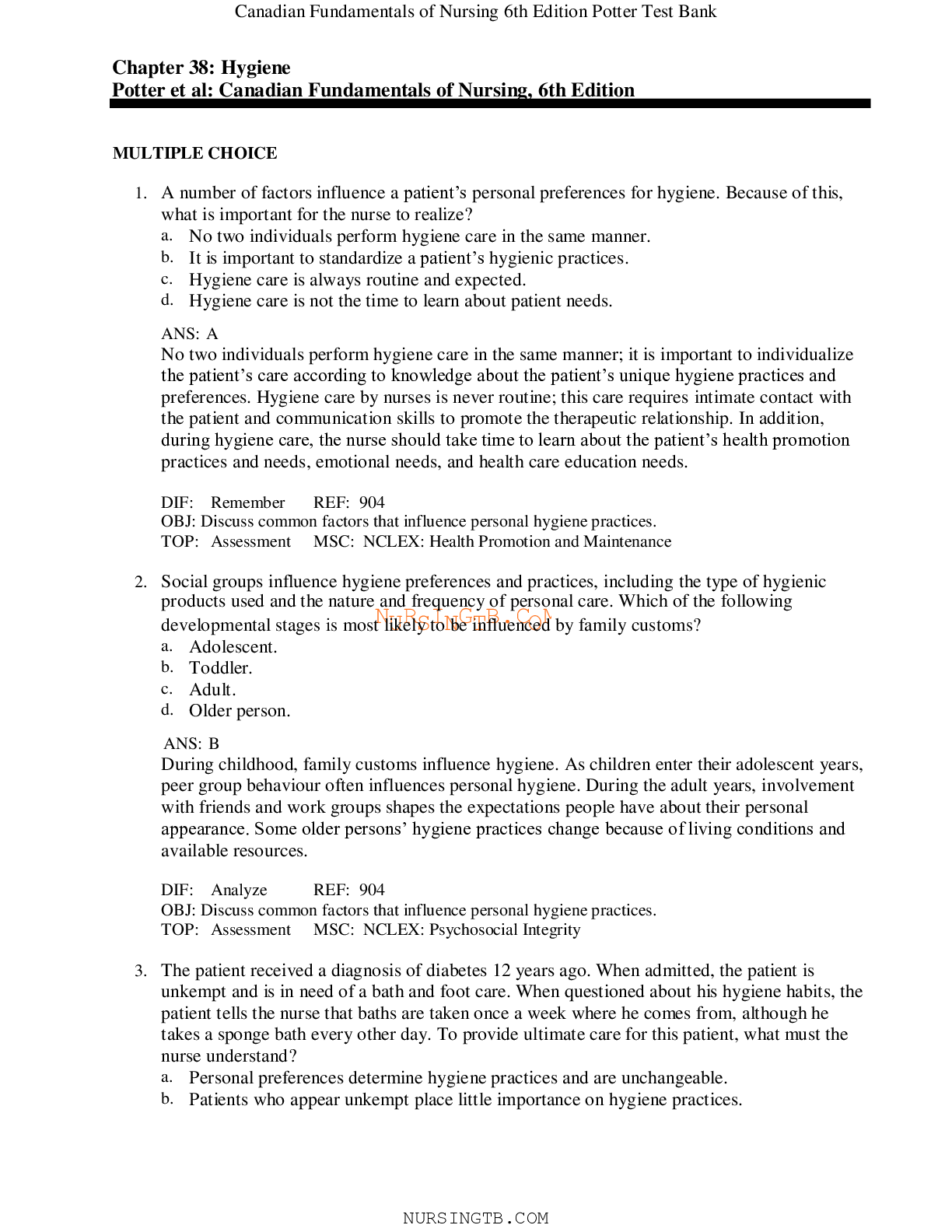
Reviews( 0 )
Document information
Connected school, study & course
About the document
Uploaded On
Aug 08, 2021
Number of pages
18
Written in
Additional information
This document has been written for:
Uploaded
Aug 08, 2021
Downloads
0
Views
55


